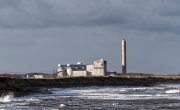GIB privatisation ‘deeply troubling’ says Scottish minister
The Scottish Cabinet Secretary for the Economy, Jobs and Fair Work, Keith Brown, has expressed concern over the progress of the privatisation of the Edinburgh-based Green Investment Bank (GIB) – saying the process is more akin to ‘fragmentation or asset stripping’ – in a letter to Nick Hurd, the UK Climate Minister.
 The £2-billion sale of the entire government share of the GIB to Australian investment bank Macquarie is expected to be completed in January and has been met with opposition from the Labour Party, the Liberal Democrats, the Greens and a number of former Conservative ministers, as well as the Scottish government, since the sale process was announced in March 2016.
The £2-billion sale of the entire government share of the GIB to Australian investment bank Macquarie is expected to be completed in January and has been met with opposition from the Labour Party, the Liberal Democrats, the Greens and a number of former Conservative ministers, as well as the Scottish government, since the sale process was announced in March 2016.
Macquarie has reportedly been chosen as the government’s preferred bidder, after fending off competition from the Sustainable Development Capital consortium. Those that oppose the sale of the bank, which was established in 2012 to support environmental projects across the UK, fear that the privatisation may see it lose its founding environmental purpose.
Lord Smith of Kelvin, the Independent Chair of the GIB, has said attracting private investors was ‘vital’ to expanding the GIB’s sphere of action, while then-Business Secretary Sajid Javid said that the government’s plans were to sell ‘at least a majority’ of its share in the GIB to ‘allow the bank to access a much greater volume of capital than would be the case if GIB were to remain in government ownership’.
In the face of fears regarding the loss of the bank’s green mission, Javid announced the intention to create a ‘special share’ in the company to protect its green credentials through a veto power to block any move away from the bank’s green mission, but concerns remain.
GIB plays a ‘vital role’ in green economy
In his letter to the climate minister, Brown said: “I am extremely disappointed with the approach that the UK government has adopted around the sale of the Green Investment Bank, which has been characterised by an unacceptable lack of communication throughout.

“Since then I have been made aware of some concerning reports that the privatisation has become more of a fragmentation or asset stripping process which runs counter to the previous commitments made to the Scottish Government. This is deeply troubling considering the vital role that the Bank serves in our green economy.”
“The veiled manner in which privatisation is taking place offers no reassurance that the future of the Green Investment Bank is being modelled in line with the reassurances offered to the Scottish Government in 2015, which state that the original purpose of the bank would be maintained.
“The UK government should update the Scottish Government on the progress of privatisation and provide clarification that previous assurances are being adhered to. I also want to be absolutely clear that the Scottish Government will voice any concerns and continue to apply pressure to ensure that our objectives remain a priority as part of the privatisation process.”
Privatising the GIB ‘makes no sense whatsoever’
A number of key figures have made statements expressing their concerns, backing the stance of the Scottish Government. Back in December 2015, the Environmental Audit Committee (EAC) stated that the sale of the GIB had been ‘rushed’ and that no sale should proceed unless the government can guarantee that it retains its green credentials.
An inquiry led by the EAC criticised the government for not acting with ‘due transparency, publication of relevant evidence, consultation, or proper consideration of the alternatives’, while also not including enough robust safeguards to protect the GIB’s green purposes.
Huw Irranca-Davies MP, then-Chair of the EAC said: “The government must ensure the Green Investment Bank continues to do what it says on the tin. If the government cannot guarantee that the Green Investment Bank will retain its green purpose in the private sector, then the sale should not go ahead.”
More recently, Vince Cable, who launched the bank in 2012 as the former business secretary, told the Guardian: “The Scottish Government has a perfectly legitimate wish to be properly consulted on the matter. The problem is that because it’s a bidding process [the UK government has ] wrapped themselves in commercial confidentiality and it’s getting in the way of having a proper policy discussion.
“Under no circumstances should they be allowing a decision to proceed which involves a potential break-up of the bank, it’s been a big success story.”
Meanwhile, Sir Richard Branson told the Telegraph last year: “The GIB is so important because it is a pioneering, government backed national institution that has led the way in green and low carbon finance.”
“It is a flag carrier [and] it is only just getting started. That’s why it’s vital that it remains government backed and green post-privatisation, preferably with government retaining a stake… to risk it being broken up rather than grown would be a lost opportunity.”
What shade of green?
Despite the rush of voices willing to speak out against the sale of the bank, which has invested £2.7 billion in 84 green infrastructure projects since its foundation, questions have been asked concerning the environmental character of some of the GIB’s investments.

In August 2015, Eunomia Research & Consulting Chairman Dominic Hogg wrote on the company’s Isonomia blog that, as of that summer, of the 12 waste projects backed by the GIB which yielded a total of 2.3 million tonnes per annum of treatment capacity ‘three per cent is for recycling, 11 per cent for AD [anaerobic digestion] and 87.5 per cent thermal energy from waste (EfW)’.
Despite EfW plants capacity to turn waste into energy, they do not encourage people to reuse, reduce or recycle waste and still contribute to carbon and greenhouse gas emissions.
Nevertheless, the GIB has invested a huge amount of capital into green infrastructure projects and a potential fragmentation of the bank after its eventual sale leaves the future of green investment in the UK up in the air until it becomes clear how the new owners intend to run the bank.








